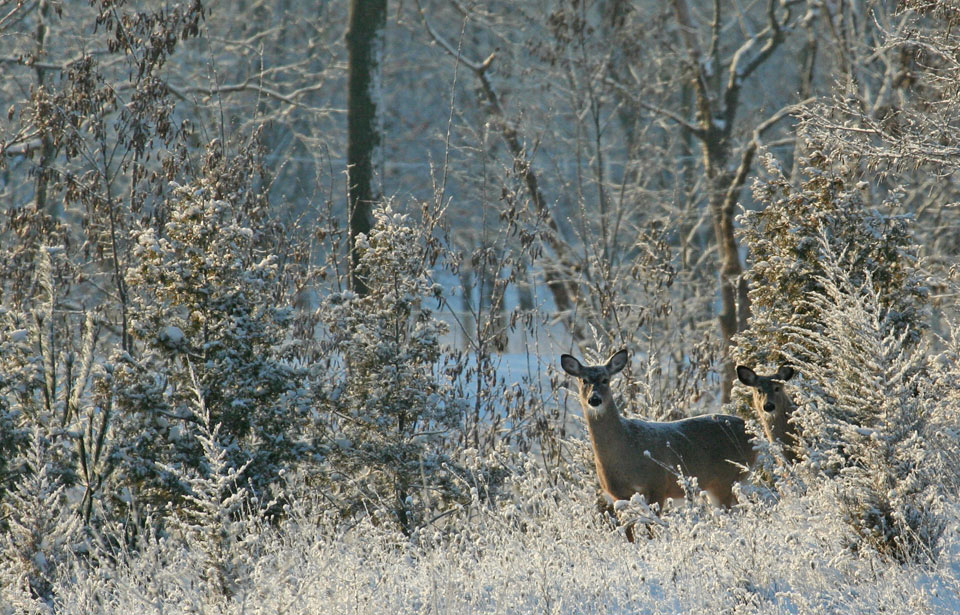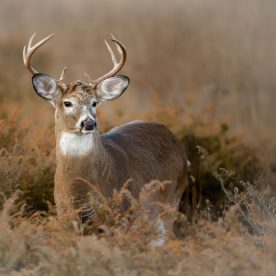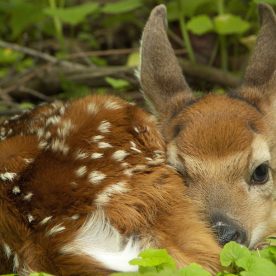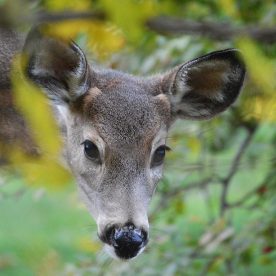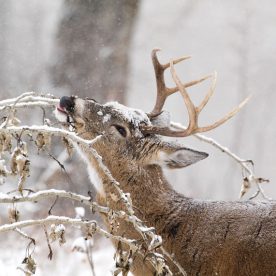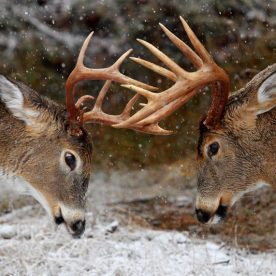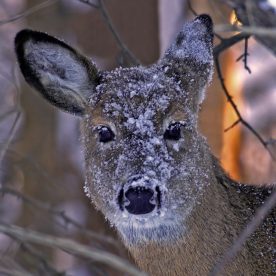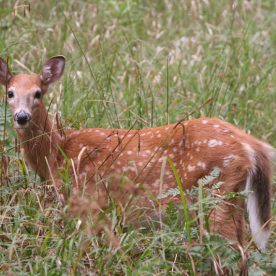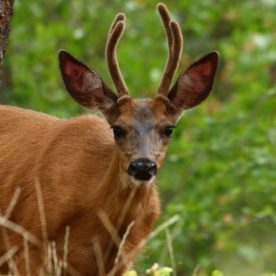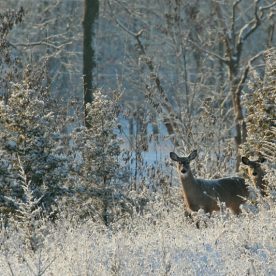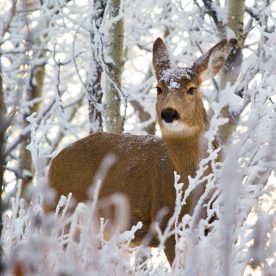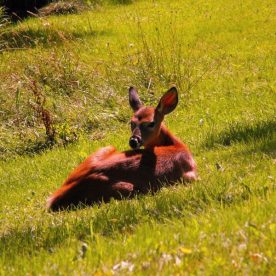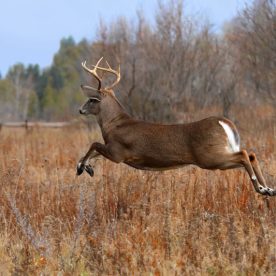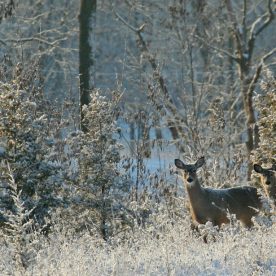Description
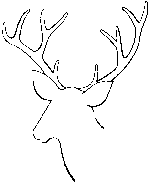 The graceful white-tailed deer Odocoileus virginianus is well known to most North Americans. Hunters and nonhunters alike recognize the animal by its habit of flourishing its tail over its back, revealing a stark white underside and white buttocks. This “flag” of the white-tailed deer is often glimpsed as the high spirited animal dashes away from people. The tail has a broad base and is almost a foot long. When lowered, it is brown with a white fringe.
The graceful white-tailed deer Odocoileus virginianus is well known to most North Americans. Hunters and nonhunters alike recognize the animal by its habit of flourishing its tail over its back, revealing a stark white underside and white buttocks. This “flag” of the white-tailed deer is often glimpsed as the high spirited animal dashes away from people. The tail has a broad base and is almost a foot long. When lowered, it is brown with a white fringe.
In summer, the white-tailed deer has a reddish pelage, or fur, on its back and sides and is whitish beneath. In winter the upper parts turn greyish. Full grown male deer frequently exceed 1 m at shoulder height and 110 kg in weight, with exceptional individuals weighing up to 200 kg in the northern part of their range.
The antlers of the mature male white-tail consist of a forward curving main beam from which single points project upward and often slightly inward. Perhaps one of every 1 000 females also bears small, simple antlers.
The white-tailed deer is hard to distinguish from the black-tailed deer. The black-tail has similar antlers and will sometimes show the characteristic “flag” of the white-tail but usually with less flare. Fortunately, for identification purposes, the black-tailed deer occurs only west of the Great Divide (its Canadian range is coastal B.C. and Vancouver Island), where the white-tailed deer is uncommon.
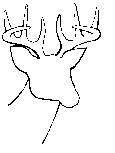 Confusion is less likely between the white-tailed deer and the darker stockier mule deer. The mule deer can be distinguished by a small white tail with a black tip and antlers that divide and redivide into paired beams and points. It also has large ears that are more like those of a mule than those of its more delicate cousin. Unfortunately people in different parts of Canada have given these two types of deer the same nickname, “jumper.” In the Prairies the mule deer is dubbed “jumper,” in recognition of its stiff-legged bouncing gait. Elsewhere people may mean the white-tail when they use the term, referring to that animal’s irregular jumping gallop when alarmed.
Confusion is less likely between the white-tailed deer and the darker stockier mule deer. The mule deer can be distinguished by a small white tail with a black tip and antlers that divide and redivide into paired beams and points. It also has large ears that are more like those of a mule than those of its more delicate cousin. Unfortunately people in different parts of Canada have given these two types of deer the same nickname, “jumper.” In the Prairies the mule deer is dubbed “jumper,” in recognition of its stiff-legged bouncing gait. Elsewhere people may mean the white-tail when they use the term, referring to that animal’s irregular jumping gallop when alarmed.
Signs and sounds
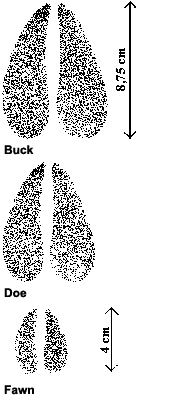 |
 White-tailed Deer Droppings
|
Habitat and Habits
Abundant food makes almost any forested or bushy area suitable for white-tailed deer during the summer, but as snow deepens the deer concentrate in “deer yards,” or areas that provide food and shelter from storms and deep snow. Sometimes the move from summer to winter range requires travelling many kilometres.
Unique characteristics
The doe leaves her fawn unattended for hours at a time. When the fawn remains bedded, the natural camouflage of its spotted coat and its almost scentless condition effectively conceal it from predators. The doe returns at intervals to suckle the fawn.
People sometimes chance to find fawns in their secluded hiding places and mistakenly believe they have been deserted by their mothers. In fact, a doe will rarely desert her fawn, and the little animals should not be touched. Human scent on the fawn may cause the doe to desert it.
Range
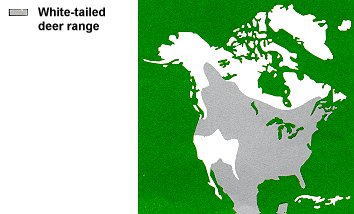 Of all North America’s large animals, the white-tailed deer is the most widely distributed and the most numerous. Its range extends from the southern tip of the continent northward well into the boreal, or northern coniferous, forest. Scattered individuals occur as far north as Great Slave Lake. In southern Canada, the white-tailed deer can be found from Cape Breton Island westward to south-central British Columbia. There were at least 15 million white-tails in Canada and the United States in 1982. Average densities throughout its range exceeded three deer per square kilometre.
Of all North America’s large animals, the white-tailed deer is the most widely distributed and the most numerous. Its range extends from the southern tip of the continent northward well into the boreal, or northern coniferous, forest. Scattered individuals occur as far north as Great Slave Lake. In southern Canada, the white-tailed deer can be found from Cape Breton Island westward to south-central British Columbia. There were at least 15 million white-tails in Canada and the United States in 1982. Average densities throughout its range exceeded three deer per square kilometre.
There are 16 recognized subspecies of white-tailed deer in North America. Only three of these are found in Canada. The northern white-tailed deer is found throughout eastern Canada, from about the Ontario-Manitoba border eastward to Cape Breton. The brushy draws (valleys), parklands, and forest fringes of the prairies, westward to the foothills of the Rockies, are inhabited by the Dakota white-tailed deer. The tawny northwestern white-tailed deer is found in southeastern British Columbia, occasionally straying down the eastern slopes of the continental divide into Alberta.
White-tailed deer are relative newcomers to much of the range they now occupy in Canada. When Europeans first explored the northern half of the continent they found deer in only the most southerly parts of Canada and this situation had not changed much at Confederation. At that time there were no deer in Nova Scotia and they were not numerous in New Brunswick. Deer were in southern Quebec and their range extended some distance down the St. Lawrence River and up the Ottawa River. Although deer were numerous in southern Ontario, none had penetrated northward beyond Lake Nipissing. There were a few white-tailed deer in south-central Manitoba, but most of the remainder of the Prairie Provinces was populated by only the mule deer.
Since then human activities, including the cutting and burning of blocks of forests, the seeding of agricultural crops, the winter feeding of cattle, the reduction of competitors such as mule deer, elk, moose, and bison, and the restriction on hunting of white-tails have helped this deer to extend its range northward and westward. Long-term easing of the severity of winters may have been an important factor. Whatever the exact combination of causes, the range of the white-tailed deer extended considerably during the late 19th and the first half of the 20th centuries. Extension of range and development of substantial populations have been somewhat more recent in Saskatchewan, Alberta, and British Columbia than elsewhere in Canada. Thus, the current range of most white-tailed deer in Canada represents a marked recent extension of northern limits. It is not surprising, therefore, that severe winters and changes in habitats cause marked sporadic declines in population levels through much of the currently occupied Canadian range.
The white-tailed deer shares some parts of its western range with its relations the black-tailed deer and the mule deer.
Feeding
During the spring and summer the white-tailed deer’s diet consists of leafy material from a variety of woody plants, grasses, herbs, and forbs. It also includes such delicacies as fiddleheads, mushrooms, and blueberries. When summer’s lush vegetation turns brown and dry in autumn, the deer must depend largely on the twigs and buds that are within their reach. Acorns are a favourite autumn food for white-tailed deer living in eastern Canada, and in Western Canada grain piles left in fields attract white-tailed deer throughout the autumn and winter. Even in winter white-tailed deer consume green forage, such as winter-green forbs, grasses, and sedges.
Even the most favourable winter concentration areas have a limited food supply. If there are too many deer using the area, the most nutritious fodder disappears rapidly, leaving foods of only marginal value for the remainder of the winter. Deep snow worsens the problem. When snow is deeper than 40 cm, deer find it increasingly difficult to move about freely and tend to follow previously broken trails. The quantity and quality of food that can be reached from these trails further limit nutritional intake at the very time that intense cold and difficult travel tend to increase the deer’s energy requirements.
Converting surplus fat stored during the late summer and early autumn meets some of this energy requirement, but once this remaining source of energy has been depleted, there is less likelihood of the deer surviving until spring. If food remains scarce and the deer begin to break down muscle tissue for energy, then the chances of survival become extremely poor. It is not surprising that those that do survive a severe winter return to their summer ranges as little more than gaunt shadows of their sleek autumn form. The green growth of spring brings welcome relief.
Breeding
Deer reproduce quickly. A healthy herd is capable of almost doubling its numbers during one favourable year. Under favourable conditions, female fawns tend to breed at six to seven months and at 12 months of age produce singletons, or one baby. Male fawns and male yearlings are sexually mature but are seldom given a chance to breed.
The white-tailed deer’s spotted, wobbly legged fawns, weighing 2 to 4 kg at birth, are born in late spring. Although birth may take place from late March to early August, most fawns are born during the last week of May or the first week of June. On high quality range twin fawns are the rule, although single births are quite common among younger females, especially those giving birth for the first time. Triplets are relatively uncommon and quadruplets occur only rarely. On poorer ranges or after a severe winter single births usually outnumber double births and multiple births do not occur.
The newborn fawn can get to its feet within minutes, and very soon takes its first nourishment from the doe’s rich milk; however, it remains relatively feeble during the first week or so of its life.
As the fawn grows stronger it begins to follow the mother about during her feeding and soon learns to supplement its milk diet by nibbling on succulent vegetation. The doe, meantime, like other adult members of the deer herd, has been feeding steadily on new spring vegetation. She has entered the spring period in lean condition and with a shabby, tattered winter coat. Gradually the coarse grey winter coat is replaced by the fine reddish summer coat. Improved food supply results in both doe and fawn becoming sleek and sturdy by midsummer.
In the early spring the antlers of the male begin to show as twin dark protrusions from the frontal bones of the head. Growth of the antlers and regaining of body weight continue rapidly through the late spring and early summer. Antlers are true bones and during growth have both an internal supply of blood through the pedicels, or branches, and an external supply in the hairy skin covering of the velvet. In late summer during advanced growth the antlers appear bulbous and distended under the velvet. The shortening days of late summer terminate growth of the antlers.
The velvet dries and begins to peel off, revealing the hard bony tissue beneath. Bucks rub their antlers against brush and small trees to speed this process. The antlers are usually shed in January although shedding may occur from December through March.
White-tailed deer are truly magnificent specimens in the early autumn. Their bodies are rounded out by reserves of fat stored for the lean months ahead. The new thick winter coat exaggerates the thickness and sturdiness of the body. Fawns have lost their spots and are now short-faced, smaller replicas of their parents. Most of the breeding occurs during the last three weeks of November although some fawns and yearlings breed in December and, rarely, into January. The peak of the rut, or period of male sexual activity, occurs during the last two weeks in November in Canada but is more variable in the southern U.S. Bucks with swollen necks, caused by hormones associated with the rut, travel almost incessantly, searching out the does and engaging in mock battles with their rivals. Sometimes a real battle develops, and occasionally the antlers of the combatants become hopelessly entangled, leaving both to die slowly.
Conservation
Deer in Canada are relatively free of serious diseases or parasites. In much of their range their natural predators, such as the timber wolf, coyote, bobcat, and mountain lion, have been greatly reduced in number and infrequently exert substantial pressure on the deer. Most of the predation on fawns occurs during the first few weeks of life. Free-roaming dogs do sometimes take a heavy toll on deer of all ages, particularly in late winter when crusted snow aids the dogs but hinders the weakened deer.
Although a series of severe winters may tend to shrink the range of the white-tailed deer in Canada, a few favourable years permit it to rebuild substantial populations, and even extend its range farther northward.
Maintaining healthy stocks of white-tailed deer is primarily a matter of keeping numbers of deer in balance with their supply of winter food. People engaged in activities that alter the landscape can improve the availability of food and shelter for deer, particularly during harsh winters. For example, logging in the forest, which normally favours deer by opening the high canopy so that new growth will start on the forest floor, can be made even more beneficial to the deer if cover is left in place to shelter them from the deep snow. In eastern Canada, hemlock is the best cover, followed by cedar, balsam, spruce, and pine. In areas where brushy or woodland cover is scarce, such as on the prairies, suitable habitat can be saved from land clearing for agriculture.
Given adequate food and shelter, healthy deer populations grow rapidly if the annual increment of animals is not hunted. Overpopulation invariably leads to pressure on food supplies, which results in malnutrition, even in the face of heavy predation. Too many deer can do immense damage to their winter range, depleting suitable browse species and sometimes preventing regeneration of valuable forest trees. Moderately heavy hunting helps prevent these natural catastrophes by holding deer numbers in check while, at the same time, providing recreation and valuable meat.
Surveys indicate that the legal kill of white-tails in 1978 was 125 000 in Canada and 1 875 000 in the U.S. By 1982, the legal kill in the U.S. had risen to about 2.6 million.
Resources
Print resources
Banfield, A.W.F. 1974. Mammals of Canada. National Museum of Canada, Toronto.
Halls, L.K., editor. 1984. White-tailed deer. Wildlife Institute Management Book. Stackpole, Harrisburg, Pennsylvania.
Hesselton, W.T., and R.A.M. Hesselton. 1982. White-tailed deer (Odocoileus virginianus). In J.A. Chapman and G.H. Feldhamer, editors. Wild mammals of North America: Biology, management, and economics. The Johns Hopkins University Press, Baltimore and London.
Rue, L.L., III. 1962. The world of the white-tailed deer. Lippincott Co., Philadelphia, Pennsylvania.
Taylor, W.P., editor. 1956. The deer of North America. Stackpole Co., Harrisburg, Pennsylvania.
© Her Majesty the Queen in Right of Canada, represented by the Minister of the Environment, 1968, 1969, 1970, 1973, 1988, 1990. All rights reserved.
Catalogue number CW69-4/7-1990E
ISBN 0-660-13465-9
Text: R.C. Passmore
Revisions: 1987; F.L. Miller, 1989
Photo: Canadian Wildlife Service



